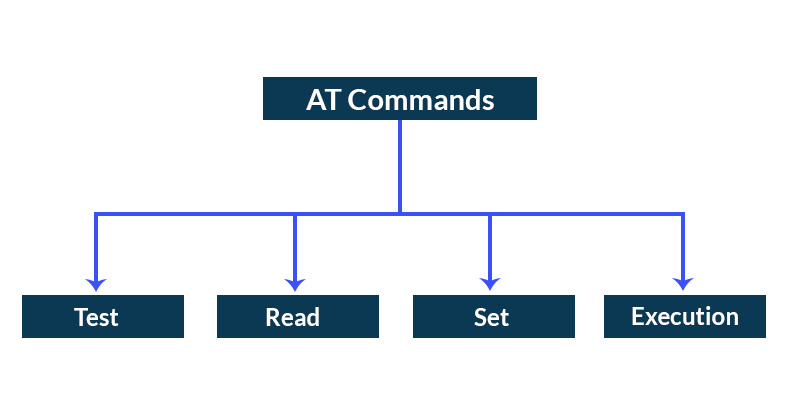TECHNOLOGY
What are AT commands? Why use AT commands?

What are AT commands?
AT commands, as an important way of communication between IoT devices, originated from Hayes smart modems. With its concise, direct and standardized characteristics, it plays a key role in the initialization, configuration, status monitoring and remote control of IoT devices. AT commands usually start with “AT”, followed by specific command parameters, and end with a carriage return (<CR>) or a carriage return line feed (<CR><LF>, i.e. “\r\n”). After receiving the AT command, the device will perform the corresponding operation according to the command content, and return the result code and return information field to indicate the success or failure of the command execution and the returned data content.
Functions of AT commands
AT commands play multiple roles in IoT devices. It can not only be used to control the switch of the device, adjust the working mode of the device, but also to configure the network parameters of the device, query the device status, etc. Specifically, the functions of AT commands include but are not limited to the following aspects:
Control and configure devices: Through AT commands, remote control of IoT devices can be achieved, such as power on and off, restart, and restore factory settings. At the same time, you can also configure the device’s network parameters, such as IP address, subnet mask, gateway, etc., as well as set the device’s working mode, baud rate, etc.
Status monitoring and data transmission: AT commands can be used to query the current status of IoT devices, such as signal strength, battery power, connection status, etc. In addition, it can also be used for data transmission, sending the data collected by the device to the specified server or cloud platform through AT commands.
Remote maintenance and debugging: Through AT commands, developers can remotely maintain and debug IoT devices, such as viewing device logs, updating firmware, and repairing faults. This greatly reduces maintenance costs and improves the reliability and stability of the device.
Application Scenarios of AT Commands
AT commands have a wide range of application scenarios in the field of Internet of Things, and our E103 WiFi module, E104 Bluetooth module and E22/E32 transparent transmission module all support AT command control. By cleverly using these AT commands, our modules can fully integrate and optimize the following application scenarios:
Smart Home:
With the E103 WiFi module, smart home devices can easily access the Internet to achieve remote control and data interaction.
The E104 Bluetooth module is good at near-field communication between devices, such as the interconnection of smart home accessories such as smart speakers and Bluetooth remote controls.
For outdoor or long-distance monitoring needs, the E22/E32 transparent transmission module provides a stable and low-power remote communication solution through the LoRa protocol.
Industrial Internet of Things:
In industrial scenarios, the E103 WiFi module ensures that device data is uploaded to the cloud platform in real time, facilitating data analysis and remote monitoring.
The E104 Bluetooth module plays a key role in device maintenance, debugging and firmware upgrades, reducing maintenance costs.
For widely distributed industrial equipment, the E22/E32 transparent transmission module uses the LoRa protocol to achieve remote monitoring and ensure stable operation of the equipment.
Smart city:
The smart lighting system uses the E103 WiFi module to achieve intelligent control and energy-saving management.
Environmental monitoring and intelligent transportation systems use the E104 Bluetooth module (or WiFi module, selected according to needs) and the E22/E32 transparent transmission module to achieve real-time data collection and intelligent scheduling of traffic flow.
Agricultural Internet of Things:
The farmland environment monitoring and irrigation system accesses the cloud platform through the E103 WiFi module to achieve precision agricultural management.
The communication between agricultural machinery and equipment depends on the E104 Bluetooth module to improve operation efficiency.
Remote monitoring points such as weather stations use the E22/E32 transparent transmission module to ensure stable data transmission.
In summary, our E103 WiFi module, E104 Bluetooth module and E22/E32 transparent transmission module can be widely used in various IoT scenarios with their comprehensive support for AT commands, providing users with efficient and reliable communication solutions.
Why use AT commands
AT commands play an irreplaceable role in communication between IoT devices. The main reasons for using AT commands are as follows:
Standardization and compatibility: The AT command set has become a universal standard for communication between IoT devices. The use of standardized AT commands can ensure that IoT devices of different brands and models can be seamlessly integrated and interoperable. This reduces the cost of system integration and improves the reliability and stability of the overall system.
Simplified development process: AT commands provide a concise and direct communication method, allowing developers to complete device initialization, configuration, status monitoring and data transmission through simple commands without in-depth understanding of the underlying hardware and communication protocols. This not only reduces the difficulty of development, but also shortens the product development cycle and improves development efficiency.
Flexibility and reliability: The AT command set supports a variety of devices and application scenarios, and can be customized and expanded according to specific needs. At the same time, the AT instruction set has been verified for a long time and has high stability and reliability. This enables IoT devices to operate stably in various complex environments and ensure the accuracy and real-time nature of data transmission.
Some problems and solutions of AT commands
The communication protocol of AT commands is usually based on serial communication (such as UART, RS-232, etc.) or network communication (such as TCP/IP, UDP, etc.). In serial communication, AT commands are sent and received in the form of byte streams; in network communication, AT commands are transmitted through specific network protocols.
However, in practical applications, AT commands also have some problems. For example, there may be differences in the AT command sets implemented by different manufacturers, which may lead to compatibility issues between devices. In addition, the security of AT commands is also an issue that needs attention. Especially when it comes to the transmission of sensitive information, security measures such as encryption and authentication need to be taken to protect the security and integrity of data.
In order to solve these problems, developers need to pay attention to the following points when using AT commands:
Understand and follow standards: When using AT commands, you should understand and follow relevant standards and specifications to ensure compatibility and interoperability between devices.
Strengthen security design: When it comes to the transmission of sensitive information, security measures such as encryption and authentication should be taken to protect the security and integrity of data. At the same time, the device should also be regularly checked and updated for security to prevent potential security risks.
Pay attention to the command format and parameters: When using AT commands, pay attention to whether the command format and parameters are correct. Incorrect command format or parameters may cause the device to fail to execute the command correctly or return incorrect results.

 BUSINESS8 months ago
BUSINESS8 months agoService Top: Understanding Role, Dynamics, and Consent in Relationships

 TECHNOLOGY7 months ago
TECHNOLOGY7 months agoSSIS 858: Everything You Need to Know

 GUIDE6 months ago
GUIDE6 months agoLookmovie2.to Legit: A Detailed Review of Safety and Features

 FASHION7 months ago
FASHION7 months agoDIY Tips to Customize Your Orange Prom Dress and Stand Out

 GUIDE6 months ago
GUIDE6 months agoTokybook: Your Gateway to the World of Audiobooks

 TECHNOLOGY7 months ago
TECHNOLOGY7 months agoUnderstanding Libgen: The Ultimate Free Ebook Library

 GUIDE8 months ago
GUIDE8 months agoLeague of Graphs: The Ultimate Guide to League of Legends Stats and Analysis

 GUIDE7 months ago
GUIDE7 months agoLook at All Those Chickens: The Story Behind the Viral Meme
















